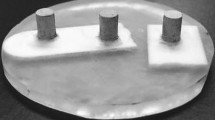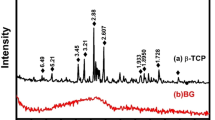Abstract
The ion release profiles and bioactivity of a series of Ti containing glass polyalkenoate cements. Characterization revealed each material to be amorphous with a T g in the region of 650–660°C. The network connectivity decreased (1.83–1.35) with the addition of TiO2 which was also evident with analysis by X-ray photoelectron spectroscopy. Ion release from cements were determined using atomic absorption spectroscopy for zinc (Zn2+), calcium (Ca2+), strontium (Sr2+), Silica (Si4+) and titanium (Ti4+). Ions such as Zn2+ (0.1–2.0 mg/l), Ca2+ (2.0–8.3 mg/l,) Sr2+ (0.1–3.9 mg/l), and Si4+ (14–90 mg/l) were tested over 1–30 days. No Ti4+ release was detected. Simulated body fluid revealed a CaP surface layer on each cement while cell culture testing of cement liquid extracts with TW-Z (5 mol% TiO2) produced the highest cell viability (161%) after 30 days. Direct contact testing of discs resulted in a decrease in cell viability of the each cement tested.







Similar content being viewed by others
References
Kates SL, Kates OS, Mendelson DA. Advances in the medical management of osteoporosis. Injury. 2007;38S3:S17–23.
Henderson B, Nair SP. Hard labour: bacterial infection of the skeleton. Trends Microbiol. 2003;11(12):570–7.
Wise DL, Trantolo DJ, Lewandrowski KU, Gresser JD, Cattaneo MV, Yaszemski MJ. Biomaterials engineering and devices: human applications. Orthopaedic, dental and bone graft applications, vol. 2. Louisville: Humana Press; 2000.
Khan RJK, MacDowell A, Crossman P, Keene GS. Cemented or uncemented hemiarthroplasty for displaced intracapsular fractures of the hip—a systemic review. Injury. 2002;33:13–7.
Barrocas AM, Eskey CJ, Hirsch JA. Vertebral augmentation in osteoporotic fractures. Injury. 2007;38S3:S88–96.
Soin S, Kapural L, Mekhail N. Imaging for percutaneous vertebral augmenation. Tech Reg Anesth Pain Man. 2007;11:90–4.
Stanczyk M. Study on modelling of PMMA bone cement polymerisation. J Biomech. 2005;38(7):1397–403.
Donkerwolcke M, Burny F, Muster D. Tissues and bone adhesives—historical aspects. Biomaterials. 1998;19(16):1461–6.
Orr J, Dunne N. Measurement of shrinkage stresses in PMMA bone cement. Appl Mech Mater. 2004;1–2:127–32.
Dunne NJ, Orr JF. Thermal characteristics of curing acrylic bone cement. ITBM-RBM. 2001;22(2):88–97.
Bergmann G, Graichen F, Rohlmann A, Verdonschot N, van Lenthe GH. Frictional heating of total hip implants. Part 2: finite element study. J Biomech. 2001;34(4):429–35.
Petty W. The effect of methyl methacrylate on chemotaxis of polymorphonuclear leukocytes. J Bone Joint Surg. 1978;60 -A(4):493–7.
Santin M, Motta A, Borzachiello A. Effect of PMMA cement radical polymerization on the inflammatory response. J Mater Sci Mater Med. 2004;15:1175–80.
Ambard AJ, Mueninghoff L. Calcium phosphate cement: review of mechanical and biological properties. J Prosthodont. 2006;15(5):321–8.
Miyamoto Y, Ishikawa K, Takechi M, Toh T, Yoshida Y, Nagayama M, Kon M, Asaoka K. Tissue response to fast setting calcium phosphate cements in bone. J Biomed Mater Res. 1997;37(4):457–64.
Ishikawa K, Takagi S, Chow LC, Ishikawa Y. Properties and mechanisms of fast setting calcium phosphate cements. J Mater Sci Mater Med. 1995;6:528–33.
Bohner M. Physical and chemical aspects of calcium phosphates used in spinal surgery. Eur Spine J. 2001;10:S114–21.
Hatton PV, Hurrell-Gillingham K, Brook IM. Biocompatability of glass ionomer bone cements. J Dent. 2006;34:598–601.
DeBruyne MAA, DeMoor RJG. The use of glass ionomer cements in both conventional and surgical endodontics. Int Endod J. 2004;37:91–104.
Byon E, Moon S, Cho S-B, Jeong C-Y, Jeong Y, Sul Y-T. Electrochemical property and apatite formation of metal ion implanted titanium for medical implants. Surf Coat Technol. 2005;200(1–4):1018–21.
González JEG, Mirza-Rosca JC. Study of the corrosion behavior of titanium and some of its alloys for biomedical and dental implant applications. J Electroanal Chem. 1999;471(2):109–15.
Takadama H, Kim H-M, Kokubo T, Nakamura T. XPS study of the process of apatite formation on bioactive Ti-6Al-4 V alloy in simulated body fluid. Sci Technol Adv Mater. 2001;2:389–96.
Kokubo T, Kim H-M, Kawashita M. Novel bioactive materials with different mechanical properties. Biomaterials. 2003;24:2161–75.
Marie PJ. Strontium ranelate; a novel mode of action optimizing bone formation and resorption. Osteoporos Int. 2005;16:S7–10.
Marie PJ. Strontium ranelate: new insights into its dual mode of action. Bone. 2001;40(5):S5–8.
Yamaguchi M, Ma ZJ. Role of endogenous zinc in the enhancement of bone protein synthesis associated with bone growth of newborn rats. J Bone Miner Metab. 2001;19:38–44.
Yamaguchi M, Ma ZJ. Stimulatory effect of zinc on Deoxyribonucleic acid synthesis in bone growth of newborn rats:enhancement with zinc and insulin like growth factor-I. Calcif Tissue Int. 2001;69:158–63.
Devine A, Dick IM, Heal SJ, Criddle RA, Prince RL. A 4-year follow up study of the effects of calcium supplementation on bone density in elderly postmenopausal women. Osteoporos Int. 1997;7:23–8.
Wren AW, Boyd D, Thornton R, Cooney JC, Towler MR. Antibacterial properties of a tri-sodium citrate modified glass polyalkenoate cement. J Biomed Mater Res B Appl Biomater. 2009;90-B(2):700–9.
Sawai J. Quantative evaluation of antibacterial activities of metallic oxide powders (ZnO, MgO and CaO) by conductimetric assay. J Microbiol Methods. 2003;54:177–82.
Wren AW, Kidari A, Cummins NM, Towler MR. A spectroscopic investigation into the setting and mechanical properties of titanium containing glass ionomer cements. J Mater Sci Mater Med. 2010. doi: 10.1007/s10856-010-4089-2.
Wren AW, Laffir FR, Kidari A, Towler MR. The structural role of titanium in Ca-Sr-Zn-Si/Ti glasses for medical applications. J Non-Cryst Solids; 2010 (Submitted).
Serra J, Gonzalez P, Liste S, Chiussi S, Leon B, Perez-amor M, Ylanen HO, Hupa M. Influence of the non-bridging oxygen groups on the bioactivity of silicate glasses. J Mater Sci Mater Med. 2002;13:1221–5.
International Standard 10993-5, Biological evaluation of medical devices Part 5: tests for in vitro cytotoxicity. geneve, Switzerland; 1999.
Boyd D, Murphy S, Towler MR, Wren AW, Hayakawa S. Analysis of gamma-irradiated synthetic bone grafts by 29Si MAS-NMR spectroscopy, calorimetry and XRD. J Non-Cryst Solids. 2009;355(45–47):2285–8.
Kokubo T, Takadama H. How useful is SBF in predicting in vivo bone bioactivity. Biomaterials. 2006;27:2907–15.
Cho SB, Miyaji F, Kokubo T, Nakanishi K, Soga N, Nakamura T. Apatite formation on silica gel in simulated body fluid: effects of structural modification with solvent-exchange. J Mater Sci Mater Med. 1998;9:279–84.
Dong-Hui F, Zheng X, Shi-pu L, Yu-hua Y. Formation of apatite in simulated body fluid. J Wuhan Univ Tech-Mater Sci Ed. 2002;17(4):44–6.
Sun J, Li Y, Li L, Zhao W, Li L, Gao J, Ruan M, Shi J. Functionalization and bioactivity in vitro of mesoporous bioactive silicates. J Non-Cryst Solids. 2008;35S:3799–805.
Loof J, Svahn F, Jarmar T, Engqvist H, Pameijer CH. A comparative study of the bioactivity of three materials for dental applications. Dent Mater. 2008;24:653–9.
Boyd D, Towler MR, Wren AW, Clarkin OM, Tanner DA. TEM analysis of apatite surface layers observed on zinc based glass polyalkenoate cements. J Mater Sci. 2008;43:1170–3.
Author information
Authors and Affiliations
Corresponding author
Rights and permissions
About this article
Cite this article
Wren, A.W., Cummins, N.M., Laffir, F.R. et al. The bioactivity and ion release of titanium-containing glass polyalkenoate cements for medical applications. J Mater Sci: Mater Med 22, 19–28 (2011). https://doi.org/10.1007/s10856-010-4184-4
Received:
Accepted:
Published:
Issue Date:
DOI: https://doi.org/10.1007/s10856-010-4184-4




